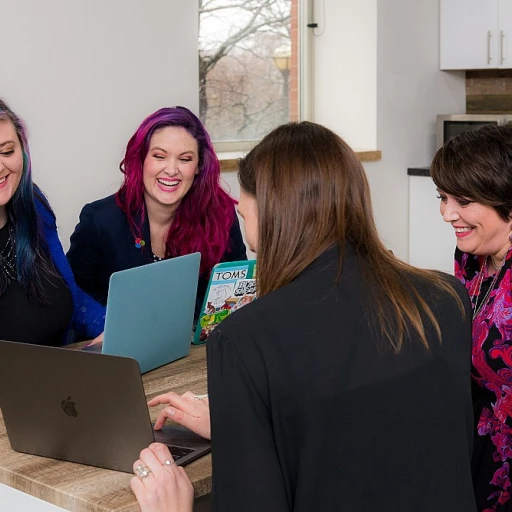
The Impact of Digital Transformation on Workplace Communication
The Influence of Technological Advancements on Communication Dynamics
Digital transformation is reshaping the entorno laboral in ways that extend beyond technological adoption. As organizaciones worldwide embrace new digital tools, the impact on trabajo communication is profound and far-reaching. Embracing these cambios is not optional but a necessity for survival and growth.
Modern communication platforms blur the boundaries for los empleados, fostering diversidad inclusion in how information is shared and consumed. From los trabajadores in headquarters to those adapting to trabajo from remote locations, there is a significant shift in how interactions occur, presenting both opportunities and challenges. Para los human resource professionals, the task is clear: integrate technology while maintaining clarity and inclusivity in messaging.
The introduction of collaboration tools such as Slack, Teams, and Zoom has demonstrated a strong influence on communication dynamics. They can enhance connectivity across diverse teams and geographic locations, fostering a sense of una mayor community. However, successful integration requires strategic planning, training, and continuous improvement to keep up with the constante evolucion of available technologies. It is critical para los equipos de recursos humanos to focus on developing habilidades that empower los empleados to interact fluidly with these tools.
Organizations are encouraged to approach digital transformation not as an immediate fix, but as an ongoing journey. Evaluating the impact of these tools and learning to pivot as necessary is essential in modern HR roles. Estos cambios potentially lead to significant advancements, shaping not just communication, but the culture and operational efficiency of a company.
To delve further into how effective HR communication can enhance the employee experience in this landscape, consider exploring insights on the topic here.
Adapting to Remote and Hybrid Work Models
Embracing Flexibility in Workplaces
The shift towards remote and hybrid work models is not a new phenomenon but one that has gained significant momentum in recent years. As organizations strive to adaptarse to these changes, they face the challenge of effectively managing a workforce that is often distributed across various locations. Adapting to these new work environments can seem daunting; however, with the right strategies, it becomes an opportunity for growth. Los empleados need to embrace flexible work schedules and take advantage of tools and technologies that facilitate seamless communication and collaboration. Organizations can implement strategies that foster engagement in this new work setting by:- Utilizing digital communication platforms that promote collaboration and connectivity among teams.
- Encouraging a culture of transparency and open communication.
- Incorporating regular check-ins and feedback sessions to ensure alignment and address any issues.
- Emphasizing the importance of mental health and well-being, providing support where needed.
Cultural Shifts and Their Influence on Communication
Cultural Adaptations to Enhance Workplace Communication
In today's rapidly changing work environment, cultural shifts within the workplace environment have become a crucial factor influencing communication. These changes are not just about adopting new technologies but also about embracing diversity and inclusion, which can lead to a more harmonious and productive work environment.
Organizations are increasingly recognizing the importance of creating a culture that is adaptive and inclusive. Such a culture not only helps in retaining talent but also in fostering effective communication among employees. The evolution of workplace culture can present some challenges, but it also offers opportunities for growth and innovation.
As organizations strive to adapt to these changes, they can benefit from implementing diversity and inclusion strategies. Such strategies do not only enhance communication but also ensure that every employee feels valued and understood. This cultural change is not just a trend; it is a reality that can lead to a more engaged workforce.
Furthermore, human resources play a pivotal role in driving these cultural shifts. This involves not only setting policies but also facilitating training programs that enhance communication skills among employees. It’s not just about adapting to change but also about seizing the opportunities presented by these cultural transformations. With the constant evolution of the work environment, adapting to these changes is no longer optional but necessary for success.
The Role of Human Resources in Facilitating Change
The Importance of HR in Driving Effective Workplace Communication
The role of human resources has become increasingly crucial in managing the constant evolution of workplace communication. HR professionals are now tasked with navigating los cambios in the entorno laboral brought on by digital transformation, los trabajadores shifting towards remote and hybrid models, and the impact of cultural shifts on how organizations operate.- Facilitating Change: To effectively adaptarse to estos cambios, HR departments must be proactive in identifying and addressing the communication barriers that arise. This includes understanding cómo los empleados interactúan within the workplace and promoting practices that enhance clarity and engagement.
- Promoting Diversity and Inclusion: Diversity inclusion is not just a buzzword, sino tambien una realidad that organizations must embrace. HR's role in ensuring diverse perspectives contribute to communication strategies can lead to una mayor creativity and innovation within the workplace.
- Developing Communication Strategies: Los recursos humanos are essential in formulating effective communication strategies that align with organizational goals. By doing so, they can provide las oportunidades necesarias para los empleados to voice ideas, concerns, and feedback, thereby enhancing overall engagement and retencion del talent.
- Supporting Employees: HR can play a pivotal role in supporting los trabajadores through dedicated training and development programs. By equipping employees with the habilidades necessary to communicate effectively, they help individuals adapt to communication demands in con una more agile and informed manner.
Training and Development for Enhanced Communication Skills
Fostering Effective Interactions Through Training and Development
In today's rapidly changing business landscape, where digital transformation and remote work models are becoming the norm, developing effective communication skills is paramount for both employees and organizations. As the workplace continues to adapt to new technologies and cultural shifts, training programs are not just a luxury but a necessity. To navigate these changes, organizations must focus on the following key areas:- Communication Channels: With the introduction of digital communication platforms, it is crucial to train employees on how to utilize these tools effectively. Understanding los cambios in how we communicate can lead to enhanced collaboration and productivity.
- Cultural Sensitivity: As diversity inclusion becomes a reality within the workplace, promoting cultural sensitivity through training can foster a more inclusive and harmonious work environment. This includes understanding how cultural differences can impact communication styles and expectations.
- Adaptive Skills Development: The constant evolution of workplace dynamics requires employees to adapt their communication styles. Training can equip workers with the habilidades necessary to handle these transitions smoothly, ensuring they're not only surviving, but thriving in a constante evolucion environment.
- Feedback and Open Dialogue: Encouraging a culture of feedback can enhance communication within las organizaciones. Training should focus on building skills for giving and receiving feedback constructively, which can lead to greater engagement and employee retention.
Measuring the Effectiveness of Communication Strategies
Evaluating Communication Methods in a Dynamic Work Setting
Efficient communication strategies can significantly improve worker engagement, retention del empleo, and organizational culture, yet measuring their efficacy can be complex. The workplace's constant evolution, driven by digital transformation and remote work adaptations, requires los recursos humanos to continually assess and refine communication approaches.One method to gauge effectiveness is through feedback mechanisms. Encourage los empleados to provide input on current communication practices, which can offer constructive insights for further adaptations. This can be accomplished through surveys, feedback forms, and regular check-in meetings. Bullet List:
- Survey Data: Collect quantitative data to understand common trends and areas needing improvement.
- Feedback Forms: Use qualitative input from employees to identify specific challenges and opportunities.
- Regular Check-ins: Facilitate open conversations to adapt strategies promptly.
Analyzing these feedback channels allows for a deeper understanding of una organización's communication climate and helps HR teams to pivot strategies effectively to match evolving needs. This process is not only essential in assessing current effectiveness but also in planning for future changes in the entorno laboral. Moreover, tracking the outcomes of implemented communication changes through metrics like engagement rates, participation in company initiatives, and employee satisfaction scores can provide clear evidence of the impact. Embracing estos cambios paves the way for a more inclusive, adaptable, and proactive culture, benefiting both individuals and the organization. Resource allocation also plays a critical role. Ensuring that adequate tools and resources are available to support communication not only simplifies processes but can boost overall productivity and satisfaction among los trabajadores. In conclusion, the measurement of communication strategies extends beyond simple data collection; it's about integrating insights to foster an environment that effectively supports adaptation and growth. This innovative approach will not only define success but also empower las organizaciones to thrive amid constant change.












